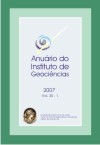Life habits analysis of the "Schuchertella" agassizi-Pthychopteria eschwegei association, Maecuru formation, Devonian, Amazonas Basin, Brazil
DOI:
https://doi.org/10.11137/2007_1_135-144Abstract
The fossils studied came from outcrops of the Maecuru and Curuá rivers, State of Pará, belonging to the upper strata of the Maecuru Formation, Eifelian age. In this formation, two associations of marine benthic invertebrate can be identified, each inferring a distinct paleoenvironment. The association analyzed occurs in medium and coarse sandstones and shows "Schuchertella" agassizi and Ptychopeteria eschwegei as predominant organisms. It was idnetified 12 species of brachiopods, 20 species of bivalves, 12 of trilobites, 8 of gastropods, 6 of bellerophonts, 3 of crinoids and 3 of tentaculitids in this association. Brachiopods are the most abundant organisms, responsible for approximately 50% of it, followed by tentaculitids and bivalves. Trilobites, gastropods and bellerophonts sum less than 10% of the aforementioned association. Crinoids were not included in the quantitative analysis because they are only found as calicinal plates and disarticulated column disks. The brachiopods showed, through their morphofunctional characteristics, suspension feeders recumbent (free-lying) epifaunal life habit or a pedicle attached mode of life. The bivalves showed a predominant suspension feeder semiinfaunal habit, attached by byssus threads to the substratum, and an infaunal mode of life. All the trilobites showed a predator/scavenger and vagile epifaunal habit. The epifaunal platyceratids represents the gastropods with low mobility (coprophagous/suspension feeders). The bellerophonts showed an epifaunal highly/medium mobility and grazing/predator habit. The tentaculitids having a semi-infaunal, suspension feeder habit. The suspension feeder forms (brachiopods, bivalves and tentaculitids) account for over 90% of the organisms, with the remaining percentage distributed among the predator/scavenger (trilobites), coprophagous/suspension feeders (gastropods), grazers/ predators (bellerophonts) and deposit feeders (rare bivalves). The predominance of suspension feeder forms corroborates the environment inferred for the association, since suspension feeders adapt more easily to rough waters and coarse sediments. The life habits showed adaptations concerning a shallow marine environment with agitated waters, well-oxygenated, normal salinity and moderate temperatures.Downloads
Download data is not yet available.
Downloads
Published
2007-01-01
How to Cite
Ponciano, L. C. M. de O. and Machado, D. M. da C. (2007) “Life habits analysis of the ‘Schuchertella’ agassizi-Pthychopteria eschwegei association, Maecuru formation, Devonian, Amazonas Basin, Brazil”, Anuário do Instituto de Geociências. Rio de Janeiro, BR, 30(1), pp. 135–144. doi: 10.11137/2007_1_135-144.
Issue
Section
Article
License
This journal is licensed under a Creative Commons — Attribution 4.0 International — CC BY 4.0, which permits use, distribution and reproduction in any medium, provided the original work is properly cited.















